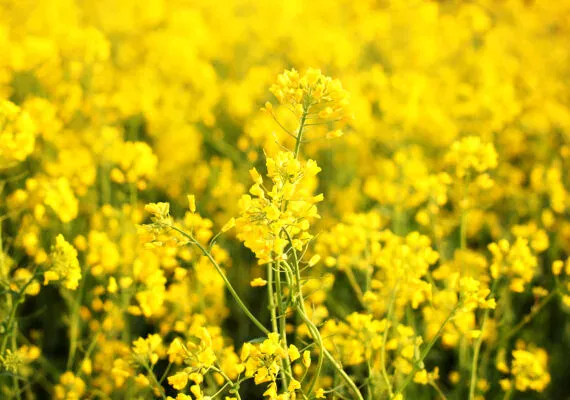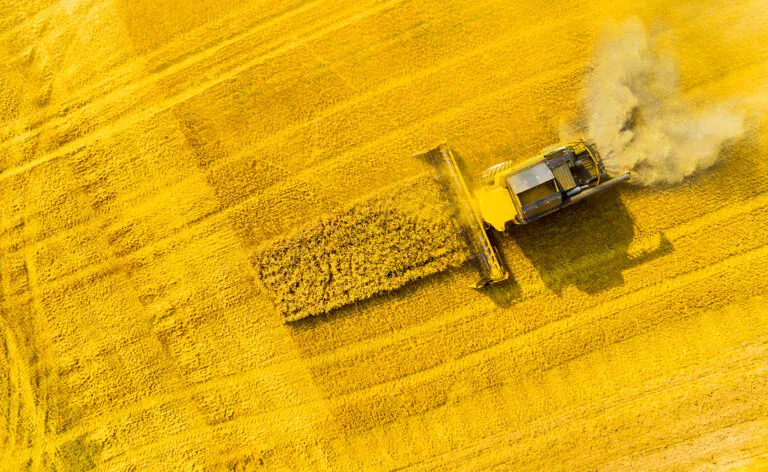
HOW TO GROW RAPESEED STEP BY STEP?
The most important aspect of rapeseed cultivation is ensuring the appropriate soil pH. The optimal pH value for this plant is 5.8. Lower soil pH results in poor growth at the beginning and subsequent stages of development. In conditions of lower pH, these plants do not adequately absorb nutrients. Therefore, the best solution is to apply liming treatment before sowing. Effective preparations include granulated lime. For rapeseed, it is advisable to use granulated calcium-magnesium fertilizers such as SuperMag.
HOW TO PREPARE THE FIELD FOR RAPESEED CULTIVATION?
To ensure proper growth, it is necessary to prepare suitable conditions. Rapeseed should be planted following crop rotation principles. The best results in yields are achieved when it is sown after early potatoes, legumes, or cereal-legume mixtures. Rapeseed should not be planted:
after sugar beets due to similar pests;
after itself due to seed quality deterioration.
However, it often happens that rapeseed is sown immediately after another crop. In this case, the remaining stubble should be destroyed by cultivation and harrowing. Then, a seedbed should be prepared to a depth of about 21 cm to allow the soil to settle before sowing rapeseed.
HOW TO SOW RAPESEED?
Rapeseed is sown at a rate of about 3.5 kg per hectare. It should be sown at a depth of 1.5 to 2 cm, resulting in approximately 70–80 rapeseed plants per square meter. Sowing winter rapeseed occurs at a specific time. Delaying it by 7 days results in an 8% yield decrease, while a 14-day delay leads to a 15% yield decrease. The best time for sowing rapeseed is August. Sowing takes place:
around August 15 in the northeast regions of Poland;
around August 20 in the central part of Poland;
around August 25 in the western regions of Poland.
By adhering to the sowing time, rapeseed in the winter period will have a well-developed root system, thick root neck, and a rosette consisting of 6–8 leaves, which positively affects its overwintering.
HOW TO FERTILIZE RAPESEED?
First and foremost, a laboratory analysis of soil nutrient content should be conducted. This will allow calculating the appropriate doses of minerals necessary for fertilizing the rapeseed field. It is assumed that to produce 1 ton of seeds with straw, approximately:
about 55 kg of nitrogen;
about 28 kg of phosphorus pentoxide;
about 45 kg of potassium oxide;
about 6 kg of magnesium;
about 14–20 kg of sulfur are needed.
Boron fertilization in the fall is crucial in rapeseed cultivation. If this element is deficient, the root system may not develop properly. Boron is also important during the flowering period of the plant. Rapeseed also requires continuous access to magnesium and sulfur. In spring, abundant nitrogen fertilization is crucial.
Calcium and magnesium are among the most important macronutrients necessary for plants. Their significance is not limited to soil pH alteration but also affects various physiological processes in the plant, ensuring high quality and yield. It is estimated that the application of 1 t∙ha-1 of granulated Polcalc III Generation lime will improve soil pH and increase rapeseed seed yield by 0.6 t∙ha-1 compared to the control, resulting in an additional income of 1860 PLN∙ha-1 (purchase price on 01.07.2022). Subtracting the average purchase price of 1360 PLN∙ha-1 for granulated Polcalc III Generation lime, the profit obtained is 1360 PLN∙ha-1. These results indicate that the use of 1 t∙ha-1 of granulated Polcalc III Generation lime allows for more efficient utilization of macronutrients from NPK mineral fertilizers, the current purchase cost of which is 3100 PLN∙ha-1 for a rapeseed seed yield of 3.5 t∙ha-1. In the case of magnesium-deficient soils, the use of granulated SuperMag lime, which contains magnesium in a plant-absorbable form, is recommended. It is estimated that the application of 1 t∙ha-1 of this fertilizer will increase rapeseed seed yield by 0.92 t∙ha-1, resulting in a profit of 2152 PLN∙ha-1 based on the purchase price on 01.07.2022.
For proper rapeseed growth, microelements are also needed. For 1 ton of harvested seeds, the plant absorbs:
from 60 to 120 g of boron;
from 10 to 40 g of copper;
from 50 to 100 g of manganese;
from 1 to 2 g of molybdenum;
from 160 to 180 g of zinc;
about 260 g of iron.
If rapeseed has access to all necessary micro and macronutrients, it will remain healthy and yield high.

HOW TO PROTECT RAPESEED CULTIVATION?
Regarding rapeseed crop protection, it is essential to safeguard it with appropriate preparations against:
emerging dicotyledonous and monocotyledonous weeds and cereal volunteers;
emerging pests;
fungal diseases.
Preparations protecting rapeseed against fungal diseases also act as growth regulators and prevent excessive vegetative growth.
HOW AND WHEN TO HARVEST RAPESEED?
Rapeseed harvest usually occurs in early July. It depends on weather conditions and the readiness of plants for harvesting. Sometimes, the entire plantation does not ripen simultaneously. To avoid losses in yields, they can be secured with special „binding” preparations to prevent seed shattering. Rapeseed is most often harvested using a combine harvester, typically with a one-phase method. To begin harvesting, plants must exhibit the following characteristics:
black seed color;
brown pod color;
moisture content below 11%.
WHAT TYPES OF RAPESEED CAN BE CULTIVATED?
There are many varieties of rapeseed in Poland, differing in size and time of maturation. It is best to gather information about each variety and adjust it to the area of cultivation and soil conditions. When cultivating rapeseed in large areas, consider cultivating varieties with different maturation times to ensure the entire yield is collected without losses due to seed shattering.
Rapeseed can be sown in two ways:
spring rapeseed – it is sown in early April;
winter rapeseed – it is sown from mid-August; sowing winter rapeseed is more popular.
WHY IS LIMING RAPESEED WORTHWHILE?
Granulated lime should be applied to rapeseed fields before sowing. It is important to note that our Polcalc products are environmentally friendly and can also be used as a top dressing after planting. The best results are achieved with the application of magnesium lime. Such liming can be done before planting. This allows achieving the optimal soil pH for rapeseed growth, which is 5.8. Consequently, the plant can properly absorb nutrients. If the soil is highly acidic, it is recommended to apply granulated carbonate lime a year before establishing rapeseed cultivation.






